
Previous Articles 5
Below are selected articles published on this site January - March 2010. We hope you will find some of interest.
Articles here have been moved from our Recent Articles & Announcements page and are in reverse chronological order.
Tuesday 2 March 2010
Field Ambulance
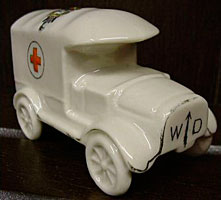
We were asked for information about the Carlton Ware model of a World War One field ambulance shown on the left. What did the WD separated by a vertical upwards pointing arrow painted on the radiator mean?
Carlton Ware Heraldic china, to which this belongs, can offer a fascinating history of the first quarter of the Twentieth Century, when it was produced. The small details found on some of the models can be serendipitous, as in this instance.
Here, WD stands for War Department, but what about the curious glyph between the initials?
Carlton Ware Heraldic china, to which this belongs, can offer a fascinating history of the first quarter of the Twentieth Century, when it was produced. The small details found on some of the models can be serendipitous, as in this instance.
Here, WD stands for War Department, but what about the curious glyph between the initials?

The arrow that separates the letters is a symbol for Government property, probably best known for having been used on convicts clothing. Also called a Pheon, it has been in use since the reign of William & Mary and items marked with it were found on the Tudor ship The Mary Rose, which sank in 1545.
The arrow frequently appeared on military boxes and equipment such as canteens, bayonets and rifles, as well as the British prison uniform from the 1870s, and even earlier on that of transportees in British penal colonies such as Australia.
Today's Ministry of Defence continues to use the mark.
The arrow frequently appeared on military boxes and equipment such as canteens, bayonets and rifles, as well as the British prison uniform from the 1870s, and even earlier on that of transportees in British penal colonies such as Australia.
Today's Ministry of Defence continues to use the mark.
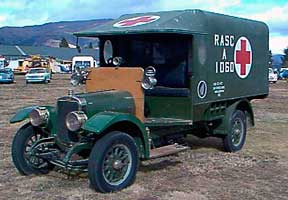
On the left we show what is believed to be the only surviving field ambulance from WW1, once named 'Gutless Gertie' and now in New Zealand.
Initially, cars were donated by individuals for the war effort to be fitted with ambulance bodies. Some wealthy families included their chauffeurs!
The Red Cross symbol used on the Carlton Ware model and on the surviving vehicle needs no explanation. You can see that the ceramic version is quite faithful to what became the Red Cross's standard body for field ambulances. © Harvey Pettit 2010.
We would like to thank Debbie Rhodes of the Wanaka Transport & Toy Museum in New Zealand for permission to use her photograph of 'Gutless Gert! Thanks also to The Cochrane & Pettit Archive of Carlton Ware for the information provided.
We would like to thank Debbie Rhodes of the Wanaka Transport & Toy Museum in New Zealand for permission to use her photograph of 'Gutless Gert! Thanks also to The Cochrane & Pettit Archive of Carlton Ware for the information provided.
Scroll down for more.
Friday 22 January 2010
Marriage Scent to Coventry!
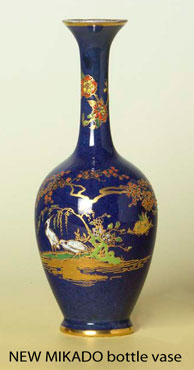

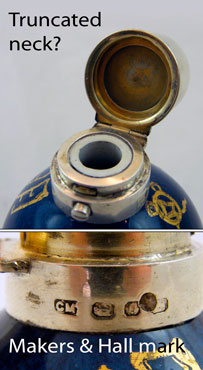
The middle picture above shows what appears to be a Chinoiserie Carlton Ware scent bottle, which appeared for sale on eBay recently and was inevitably described as rare (as is so much on the online auction house!) The decoration is part of the CHINESE FIGURES pattern; the metal cap is silver.
It is a good example of what in the antiques business is called a marriage, where two or more authentic items are combined, usually in an attempt to add value. The bottle vase in the picture on the left shows how the Carlton Ware part of the union looked before truncation.
It is a good example of what in the antiques business is called a marriage, where two or more authentic items are combined, usually in an attempt to add value. The bottle vase in the picture on the left shows how the Carlton Ware part of the union looked before truncation.
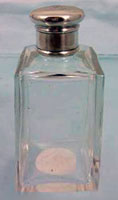
The silver cap is probably taken from a glass scent or cologne bottle of the type shown on the right. At first sight, the marriage is quite convincing. The hall-marked silver top was assayed in Birmingham, not Coventry as our playful headline indicates, and gives a date of 1895, more than thirty years before CHINESE FIGURES was introduced. The picture, above right, shows the hall-mark, as well as indicating that the neck has been cut, evident from the exposed unglazed white body.
Hall-marked silver fittings were used with Carlton Ware, most notably with smoking accessories such as tobacco jars, most of which date from the 1920s and 30s. Usually, these were used to strengthen and decorate rims to lids, as shown on the items below- some are a little tarnished.
Hall-marked silver fittings were used with Carlton Ware, most notably with smoking accessories such as tobacco jars, most of which date from the 1920s and 30s. Usually, these were used to strengthen and decorate rims to lids, as shown on the items below- some are a little tarnished.
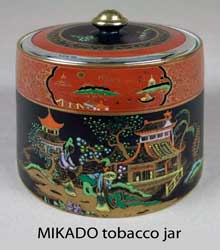

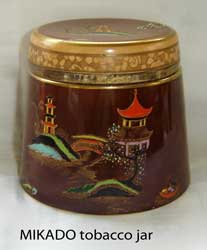 © Harvey Pettit 2010
© Harvey Pettit 2010Images by Harvey Pettit © Copyright 2009. All rights reserved.

